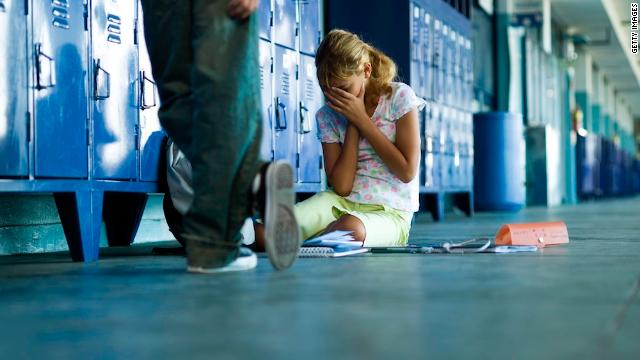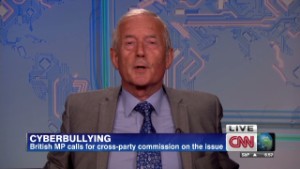- Back to Home »
- School bullying's chilling new front

- Francey Hakes: Several recent suicides of young people appear to be linked to bullying
- Why does bullying seem more common, virulent, damaging today? The Internet, she says
- She says kids are desperate, hopeless when their torment is widespread in tweets, "likes"
- Hakes: Schools must do better; parents must police kids online lives for signs they are bullies
Editor's note: Francey Hakes served from 2002 to 2012 as a federal prosecutor and from 2010 to 2012 as the first National Coordinator for Child Exploitation Prevention and Interdiction at the US Justice Department. She is CEO of Francey Hakes Consulting, which provides advice on child protection and national security. She blogs at FranceyHakes.
(CNN) -- Can cruel words really kill?
The answer, unfortunately, is yes. Recently, a teenage boy killed himself in Connecticut. Bart Palosz was just 15 when he took his family's shotgun and decided, apparently, that he had no other option but suicide. Last year, 12-year-old Joel Morales of New York hanged himself in his family's home. Earlier this year, 17-year-old Rehtaeh Parsons of Nova Scotia, Canada, died from self-inflicted hanging injuries.
What did these two boys and one girl have in common?
They appear to have been bullied to death, friends and family members have said. For Bart, it was his size and Polish accent that the bullies repeatedly targeted. With Joel, bullies targeted him because of his small stature and stuttering. Joel's mother said she reported this to the school, but the bullying merely escalated.

Rehtaeh was the target of a bullying campaign after she made allegations that four teens sexually assaulted her. After the alleged assault, during which at least one photo was taken, someone distributed the photo, an illegal act, and still police indicated at the time that they would charge no one.
Rehtaeh's mother said her daughter suffered more than a year of harassment where her tormentors used the photo to ruin her reputation and break her spirit. We learned only last month, far too late to help Rehtaeh, that officials have finally charged two people in connection with the distribution of the photo.
Many schools say they have zero tolerance to bullying policies in place. In fact, officials at Cowetta Intermediate High School in Oklahoma say they have just such a policy. Authorities are still investigating whether 15-year-old Triston Stephens, who shot and killed himself in that school's bathroom on a Monday morning earlier this year, was a target of bullying. Some parents in the district said school officials ignored bullying that was taking place there.
Why do these problems seem more frequent and the bullying more vicious than ever before? After all, bullying existed long before cyberspace, social networking and text messaging. What has changed?
Are bullies meaner? Are there more of them? Why do children who are bullied today experience overwhelming feelings of isolation and despair, such that they feel compelled to end their young lives rather than endure any more torment?
The answer is simple. Now one person or a small group of bullies can exponentially raise the torment to an unimaginable level in cyberspace. One nasty comment can be "liked" on Facebook, retweeted or forwarded dozens or hundreds of times in an instant, making it seem to the bullied child that the whole world is out to get her.
 J.C. Penney ad angers parents
J.C. Penney ad angers parents  What can be done about cyberbullying?
What can be done about cyberbullying?  Cyberbullying prompts teen's suicide
Cyberbullying prompts teen's suicide Teens naturally feel a need to belong, to fit in. When they are bullied, especially by those using technology as a weapon, it may seem that they are all alone and that everyone they know is participating in the hate. The bullying is also much harder to escape, no longer limited to occasions when bully and victim are in the same place.
It can go on anywhere and anytime with the victim not only receiving bullying texts or tweets or posts, but also knowing that the bully is gratified when others read, view, or repost the nasty comments or photos.
Teens can fear repercussions if they disclose this abuse. And, yes, let's call it abuse since that is what goes on in a bullying case. They may feel they will never escape the reputation the bully has built for them and then see no alternative to suicide. Tragedy flows from such desperation.
Is there a solution?
Clearly, zero tolerance policies don't always work. There are definitive steps schools and parents should take. It's not enough for schools to declare zero tolerance, they must also engage their students in wide-ranging discussions on bullying and its impact on the victims.
Some schools have student-lead councils where rules are established and bullying accusations are adjudicated by the students themselves. Peer pressure works both ways, after all. Schools must establish clear rules and enforce severe consequences for students who bully at school, whether it is in person or via electronic devices issued by or used on school property.
Schools should also monitor cyberbehavior by students. There are good software tools that monitor cyberactivity in real time and flag threats based on keyword libraries that are specific to threatening, bullying, suicidal or violent language. Every school should have this kind of sophisticated monitoring to capture such behavior.
Parents should be equally responsible. Parents are often told to monitor their children's cyberbehavior to protect them from being groomed by predators or from sending illicit images of themselves. But parents should also monitor their children to see if they are doing the bullying.
They should talk broadly about cybersafety with their children.
They should talk to their children about the effect of one post or one photo on their futures. They should regularly monitor their child's technology, whether on social networking sites or on devices themselves.
It is time to reframe the debate over bullying.
It is not just "mean girls" or "boys being boys." It is the aggressive emotional abuse of a child, and we must all stand against it. Lives depend on it.
Follow us on Twitter @CNNOpinion.
Join us on Facebook/CNNOpinion.
The opinions expressed in this commentary are solely those of Francey Hakes.







